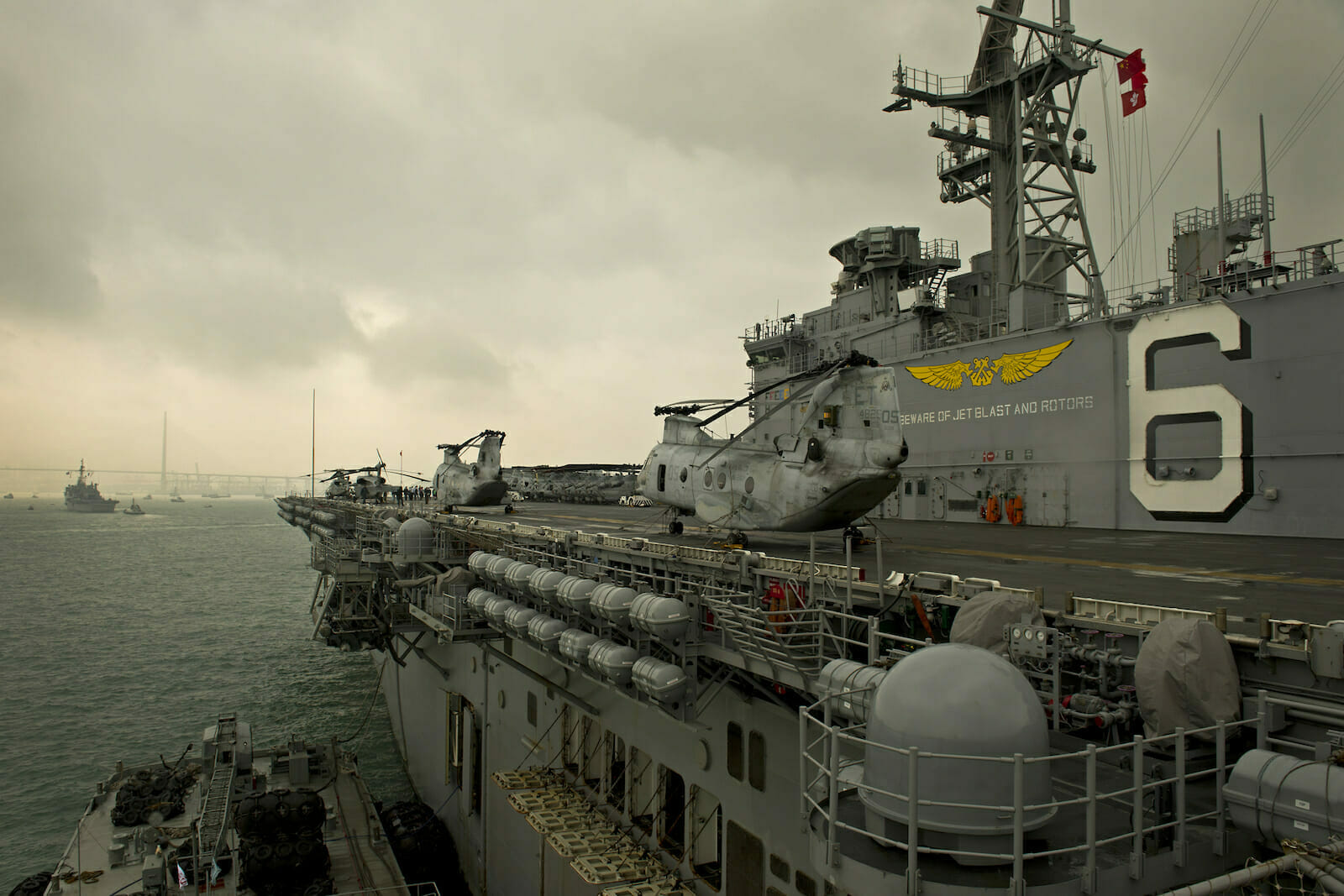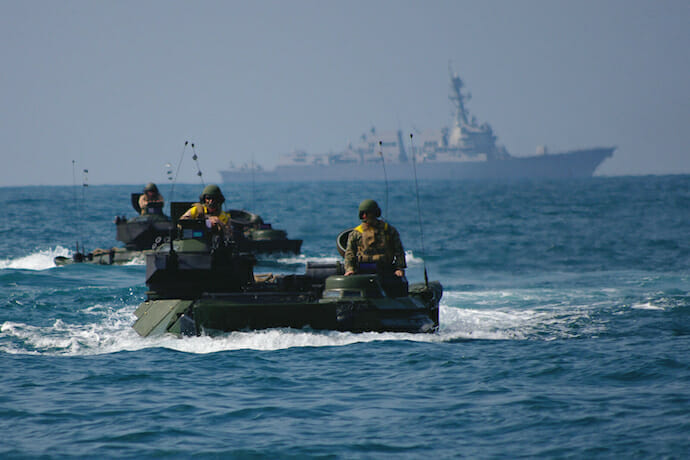
A Multidimensional Maritime Chessboard: Beijing, Taipei, and Washington in the Indo-Pacific
Few areas of contemporary grand strategy command as much attention as U.S.-China relations. Recently, Beijing and Washington’s fragmenting relations have aroused a multitude of concerns from countries in the Indo-Pacific sphere. As both powers seek to gain influence in this region, analysts question how (or if) both powers can come to a reconciliation that allows third-party countries to maintain agency amidst great-power competition. But transparently, perhaps these countries’ trepidation is warranted, especially considering Beijing’s unrelenting pursuit of authority in the South China Sea and the Taiwan Straits.
Moreover, cross-strait tensions have reached an all-time high. Beijing’s “grey-zone” activities — air and water encroachments intended to intimidate and evoke the threat of war without actual military confrontation — have increased at an alarming rate since mid-September, deeply unnerving Taipei. Yet to Beijing’s chagrin, Taiwan has also garnered international recognition for its exemplary handling of the COVID-19 pandemic and its deepening relations with Washington, especially under the Trump administration. And while Trump’s mercurial tendencies often draw harsh criticism from American commentators, such tendencies occasionally work to Taipei’s advantage, as relations have strengthened in an unprecedented way under his leadership. In fact, according to a YouGov survey, Taiwan was the only place that favored a Trump victory in the recent U.S. election. Hence, Taiwan is an anomaly.
Recently, Kelly Craft, the U.S. ambassador to the UN, originally planned to visit Taiwan just days after Secretary of State Mike Pompeo’s announcement of intent to lift self-imposed restrictions on engaging with Taiwanese governmental officials. But today, Morgan Ortagus, the State Department spokesperson, said that all overseas trips (including Craft’s trip to Taiwan) have been canceled in order to prioritize a smooth transition to the incoming Biden administration. While these new developments will likely inflame tensions with Beijing as indicated by the recent commentary published by Chinese state-media outlets like Xinhua News Agency and CGTN, Washington’s change in policy was predictably well-received by Taiwanese officials like Joseph Wu, Taiwan’s minister of foreign affairs.
Putting all of this into consideration, there remains a great need to preserve this momentum after Biden’s inauguration, as many of Taipei’s interests align with Washington’s. For one, Washington considers Taipei a valuable strategic partner in the region. Despite its status as the Republic of China (ROC) and not an independent country per se, the United States has maintained a military partnership with Taiwan since the 1980s, when Washington first pledged and sold billions of dollars worth of arms to Taipei. In October 2020, the U.S. State Department approved a $2.4 billion sale of Harpoon Coastal Defense Systems, comprehensive defense packages that include over-the-horizon missiles, radar trucks, and associated contracting and “logistics support,” to Taipei. October’s pledges were followed by the approval of four aerial drones and a Field Information Communications System in November and December, respectively. In total, the United States has pledged over $5 billion worth of arms to Taiwan in 2020 alone. When she delivered her speech on Taiwan’s National Day on October 10th, President Tsai Ing-wen briefly referenced the contentious sovereignty disputes in the South China Sea to illustrate how “democracy, peace, and prosperity in the Indo-Pacific are currently facing serious challenges.”

Some means of support for a “Free and Open Indo-Pacific” (FOIP), one of the Trump administration’s top priorities vis-a-vis China, will likely carry forward into the Biden administration. While Biden’s support for FOIP, phrased as such, remains unclear (Biden’s rhetoric has hinted instead at a “secure and prosperous” and “Asia-Pacific”), Biden’s Secretary of State pick, Antony Blinken, indicates that the president-elect hopes to counter China through a greater reliance on allies throughout the Indo-Pacific region. If Blinken’s Taiwan attitudes fall in line with those of his predecessor — which his recent phone call with Taiwan’s de facto ambassador Hsiao Bi-Khim could indicate — U.S.-Taiwan economic and military ties will hold fast through the presidential transition.
Nowhere do the interests of China, Taiwan, the United States, and Indo-Pacific littorals clash more than they do in the contentious South China Sea. China’s interest in the South China Sea stems from a number of geopolitical concerns — energy security, the protection of vital shipping lanes, and the projection of naval power, to name a few. The South China Sea is home to vast reserves of oil and methane hydrates — frozen, energy-rich methane chunks capable of fueling a growing demand for energy in a country with a rapidly-expanding middle class. CSIS China Power finds that over 60% of China’s shipping travels through these contested waters, and numerous Asia-Pacific powers — China, the Philippines, Vietnam, and others — compete for fishing rights.
Moreover, China has constructed several artificial islands in the South China Sea, many of which contain airstrips and could potentially play a military role in a blue-water naval engagement. While some experts argue that these islands are too small, remote, and vulnerable to harsh weather to be of much military use, there is no doubt that these islands’ presence signals a coordinated effort to expand China’s presence in the sea. China’s recent construction of a dry dock in Hainan Province signals the People’s Liberation Army (PLA) Navy’s intent to place at least one Type 002 aircraft carrier in the South China Sea. (China currently possesses two aircraft carriers, the Shandong and the Liaoning, but has plans to construct more in coming years.)
The South China Sea remains a subject of legal and geopolitical contention as surrounding states vie for fishing and energy resource access. This particular maritime domain stands out not only as a source of cross-strait tensions, but also as a catalyst of occasional violent clashes between China and other countries. On July 12th, 2016, the Permanent Court of Arbitration based in The Hague determined that in a tribunal between the Philippines and China, Beijing’s argument for inherent historic rights within the waters that they deem to be a part of their “nine-dash line” has no legal merit under international law. Moreover, the Philippines also requested that the third-party adjudicators determine whether some of the Spratly Islands features claimed by both parties are high-tide features (islands or rocks), or low-tide features (low-tide elevations or submerged reefs).
The status of these features can be determined by the provisions in the United Nations Convention on the Law of the Seas (UNCLOS), ratified in 1982. As per UNCLOS, none of these features are capable of consistently sustaining human habitation or economic life of their own, hence their designation as rocks, low-tide elevations, or completely submerged features. Therefore, the aforementioned Spratly features fail to generate their own 200 nautical-mile exclusive economic zones (EEZs). This is problematic for Beijing, whose artificial islands and other activities violate the Philippines’ sovereign economic rights under the provisions of UNCLOS.

Predictably, this deeply goaded Beijing. Chinese Foreign Minister Wang Yi’s remarks from 2016 reaffirmed China’s staunch opposition to the ruling. Interestingly enough, Taipei opposed it just as strongly due to the tribunal’s designation of the Taipei-administered land feature Itu Aba (also known as “Taiping Island”) as a rock rather than an island. However, unlike the PRC, the ROC made no reference to historic rights in its claims, tacitly distancing its stance from its neighbor across the Taiwan Strait and even suggesting that the ROC does not claim the waters within its U-shaped line. However, the ROC finds itself in a geopolitical quagmire because it created the baseline for the PRC’s current maritime claims before the Chinese civil war that ultimately led to the ROC leadership’s exile to Taipei in 1949. In other words, Beijing’s South China Sea claims are tethered to those of Taipei’s. If the ROC were to make any clarifications on its maritime claims that somehow undermined the PRC, Beijing would likely interpret it as a substantial step towards declaring independence. This quandary unveils just how multidimensional and contentious the South China Sea arena truly is–even for cross-strait relations.
China’s encroachments in the South China Sea and its efforts to suppress Taiwan’s international standing shed a light on the coercive measures it is willing to undertake in crafting its diplomatic, economic, and military statecraft. In July of last year, Pompeo made a monumental foreign policy move by declaring Washington’s formal endorsement of the 2016 tribunal ruling for the first time. Just a few months later, the United Kingdom, Germany, and France submitted a joint note verbale to the UN, reaffirming, inter alia, UNCLOS’s importance in ocean governance and their firm stance on abiding by the tribunal ruling.
Meanwhile, the Netherlands issued its own Indo-Pacific report (which is not yet available in English) and even issued a clarion call for the European Union to vie for observer status in the ongoing China-ASEAN Code of Conduct Negotiations. This suggests that Washington’s changing position carries a great deal of weight. Pompeo’s announcement, along with China’s increasing maritime activities in the Taiwan Straits and the South China Sea, likely provided the aforementioned European countries the bandwidth to advocate for bolder responses to China’s violations of international maritime law. It is also worth noting that Taipei welcomed Pompeo’s statement, even as it also used this announcement to reaffirm Taiwan’s own territorial and maritime claims.
As the United States and its allies usher in a new era of American leadership in the coming days, it’s critical to keep in mind the myriad of known unknowns remaining in the Indo-Pacific maritime theater. The PLA’s recent absence from its annual Military Maritime Consultative Agreement (MMCA) talks with the U.S. Indo-Pacific Command is a sobering reminder of the challenges that the U.S. and its allies will face. As such, it behooves the incoming Biden administration to continue to uphold the freedom of the seas, or what might be better known as freedom of navigation.
The United States must reassure its partners that it will counterbalance and deter China’s efforts to intimidate Taiwan and other littoral states through its aggressive military actions in the Taiwan Straits and the South China Sea. And though the State Department just lifted the regulations that govern how American diplomatic personnel interact with their Taiwanese counterparts this past weekend, some have expressed concern about the timing of when this change was made, and thus might present a hurdle for the incoming Biden administration. Nonetheless, given the increase of high-ranking meetings between Washington and Taipei, we can only hope that the Biden administration will still enjoy a great amount of maneuverability in assuring Taipei that Washington is committed to navigating these uncertain waters. Washington has a rare opportunity to work with Taipei and other regional players in a world where China is a formidable force in every domain, including the seas.


